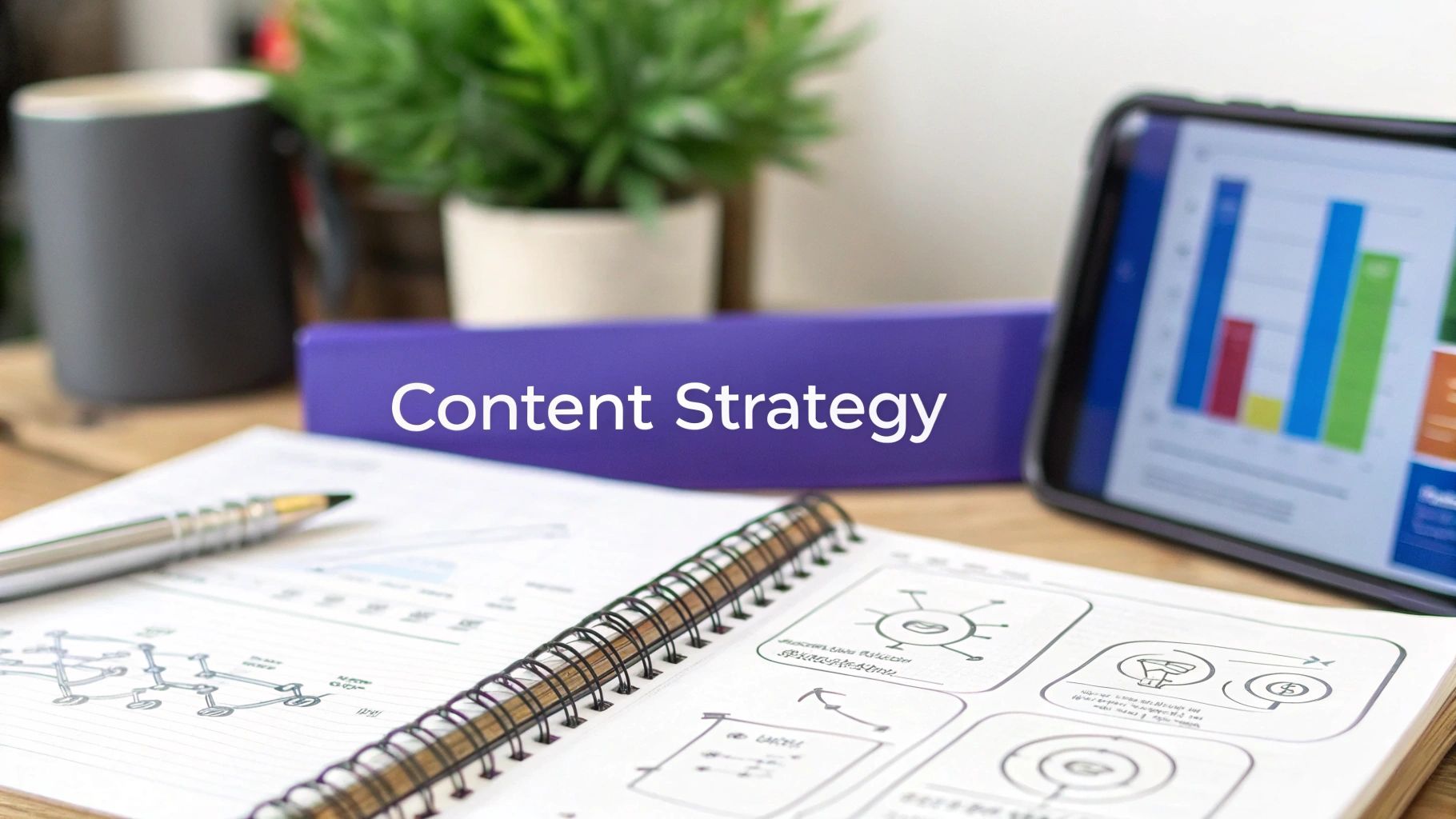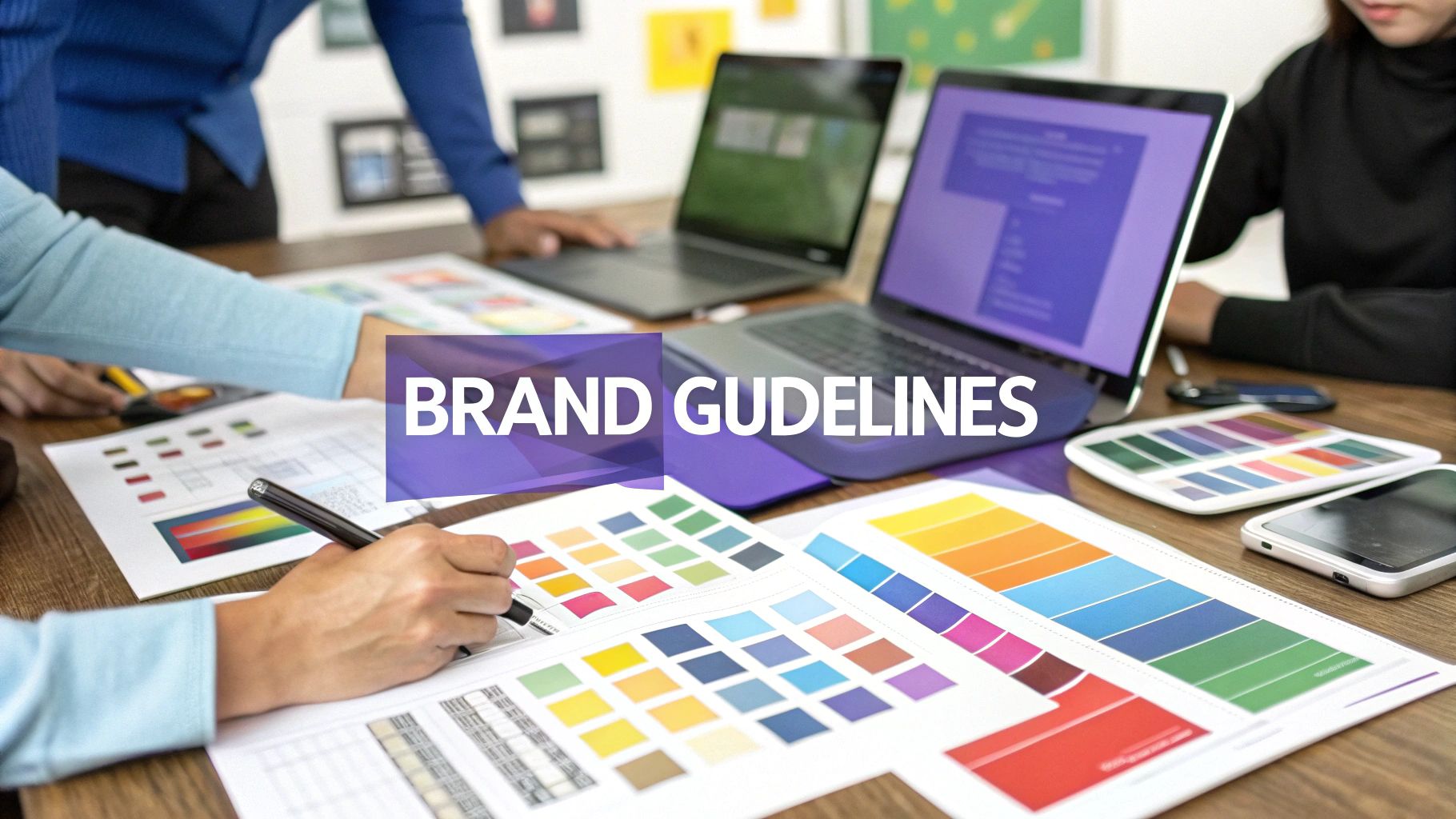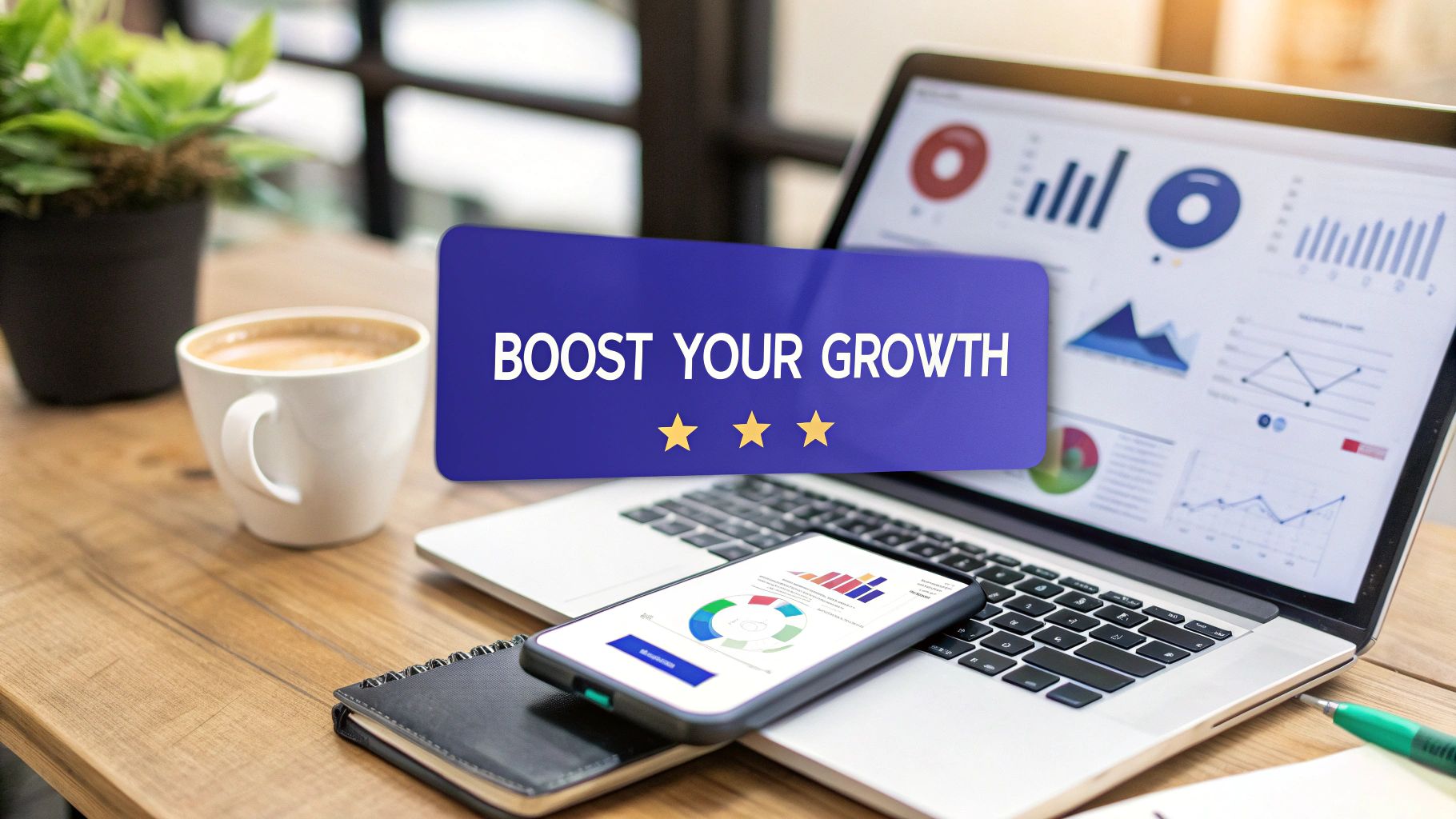Why Your Current Social Media Content Strategy Isn't Working
Do you ever feel like you're playing a social media game you just can't win? You post consistently, use all the "right" hashtags, and follow the best practices, but your engagement is flat and your follower count is stuck. If this sounds painfully familiar, you're definitely not alone. The old playbook—just being present and posting a lot—isn't enough anymore to build a social media content strategy that actually works. The issue isn't your effort; it's that your tactics are out of sync with what modern audiences want.
Think of your strategy like a fishing trip. In the past, you could just cast a wide net into the ocean and hope for the best. Today, that ocean is packed with other boats. To succeed now, you need to know exactly which fish you’re after, what bait they love, and the precise time and spot where they feed. Simply showing up with a generic net is a surefire way to go home empty-handed while others celebrate their big catch.
The Myth of "More Is Better"
One of the most common traps brands fall into is believing that posting more frequently will automatically lead to better results. This "content treadmill" approach often leads to burnout for your team and, worse, a nosedive in content quality. Your audience doesn't want to be spammed with generic updates; they crave content that educates, entertains, or inspires them. A single, thoughtful post that starts a real conversation is far more valuable than five bland ones that get scrolled past.
The most successful brands have moved from a volume-first mindset to a value-first one. They take the time to understand their audience's motivations and problems, then create content that speaks directly to those needs. This approach builds a loyal community that doesn't just see your content but actively shares and supports your brand. It's about creating meaningful moments, not just filling slots on a calendar.
Navigating a Fragmented and Crowded Space
The challenge is amplified by just how big and complex social media has become. The number of global social media users is expected to hit around 5.42 billion in 2025. On top of that, the average person uses 6.83 different social networks every month. This creates a scattered environment where attention is the most valuable and scarcest resource. To see more on this, you can check out the latest research on global social media usage statistics from Sprout Social.
This data reveals a critical mistake many brands make: treating all social platforms the same. The screenshot below shows just how different platform usage can be across various groups.
What this chart proves is that a one-size-fits-all social media content strategy is doomed from the start. The kind of professional content that does well on a network like LinkedIn would likely flop on a visual, trend-focused platform like TikTok. True success comes from customizing your message, format, and tone for each platform's unique audience, turning the digital noise into a presence that truly connects.
Building Your Strategic Foundation That Actually Drives Results
Posting on social media without a plan is like a ship without a rudder—you'll get pushed around by every new trend and end up going nowhere. A real social media content strategy is anchored in purpose. It doesn't start with, "What should we post today?" but rather, "What are we trying to achieve for our business?" This simple shift from random content to goal-driven actions is what separates accounts that grow from those that just exist.
Your business objectives, social media goals, and daily content tactics should all be directly connected. Think of it as a chain of command, where every action serves a higher purpose.

This diagram makes it clear: every tweet, Reel, or story you post is a tactic. Each tactic should support a specific social media goal, which in turn helps you hit a larger business objective, like boosting revenue or increasing your market share.
From Vague Personas to Deep Audience Insights
The next step is knowing exactly who you're talking to. Many brands stop at basic demographics like age and location. But an effective strategy goes deeper. What truly motivates your audience? What problems are they trying to solve when they open a social media app? Understanding this "why" helps you create content that connects on an emotional level, earning genuine engagement instead of just a passive glance.
This is especially critical when you consider how much time people spend on these platforms. With social media usage expected to hit 63.9% of the world's population in early 2025, and users spending an average of 2 hours and 21 minutes on them daily, your content has to be valuable to earn even a moment of their attention. You can dive into more of this data by exploring the full global social media research from Smart Insights.
Strategic Platform Selection: Go Where Your Audience Lives
Finally, a solid foundation means choosing your platforms wisely. The goal isn’t to be everywhere; it's to be where it matters most for your specific audience. A B2B tech company will gain more traction by sharing industry insights on LinkedIn than by trying to master dance trends on TikTok. On the flip side, a fashion brand will get the most out of visual-first platforms like Instagram and Pinterest.
This focused approach saves you time and energy, concentrating your efforts where they will produce the best results. To create a strong base for your social presence, think about a content pillar strategy that lines up your core topics with the platforms your audience uses most.
The table below breaks down how different platforms serve unique strategic goals, helping you make a more informed decision.
Platform-Specific Content Strategy Comparison
A comprehensive comparison of content types, audience demographics, and strategic approaches across major social media platforms
| Platform | Primary Content Type | Audience Demographics | Best For | Content Frequency |
|---|---|---|---|---|
| High-quality visuals, Reels, Stories | Gen Z, Millennials | Brand Building, E-commerce | 3-5 times/week | |
| Professional articles, industry news | Professionals, B2B decision-makers | Thought Leadership, Networking | 2-3 times/week | |
| Community posts, videos, events | Broad (Gen X, Boomers) | Community Building, Local Ads | 3-5 times/week | |
| TikTok | Short-form video, trends | Gen Z, younger Millennials | Brand Awareness, Viral Reach | 4-7 times/week |
As you can see, each platform has its own specialty. Your job is not to conquer every platform, but to master the ones where your audience is already waiting to hear from you.
Content Creation Systems That Scale Without Burning Out
A great strategy is just the starting point. Without a practical system for creating high-quality content, even the best plans can fall apart. The constant pressure for new posts often leads to creative exhaustion. The most successful brands avoid this "content treadmill" not by posting more, but by building smart systems that value consistency and genuine connection over chasing viral moments. This transforms your social media content strategy from a daily scramble into a predictable, scalable process.
The secret is to shift from reactive, day-to-day posting to proactive, theme-based planning. Think of it like a restaurant. A chaotic kitchen would be one where the chef only decides what to cook when a customer orders. A successful restaurant, however, plans its menu in advance based on seasonal ingredients and diner preferences. Your content should operate the same way, planned around core content pillars—the 3-5 key topics your brand is an expert on. These pillars become the reliable themes your audience looks forward to, making sure every post strengthens your brand's identity.
Structuring Your Content Calendar for Success
A well-organized content calendar is the framework of any scalable creation system. It’s more than a schedule; it’s a strategic map that mixes different content types to keep your audience interested. A frequent misstep is to fill the calendar with promotional posts, which can feel like non-stop ads to your followers. Instead, aim for a healthy mix:
- Educational Content (40%): Solve your audience's problems with how-to guides, tutorials, and industry tips.
- Entertaining & Engaging Content (30%): Build a community with behind-the-scenes looks, interactive polls, quizzes, and user-generated content (UGC).
- Promotional Content (20%): Share information about your products, services, sales, and customer testimonials.
- Inspirational Content (10%): Post success stories, motivational quotes, and material that reflects your brand's core values.
This balanced method ensures you are consistently offering value, which builds the trust needed for your promotional content to land effectively. For a clear picture of what a well-planned calendar looks like, this example from Buffer shows a simple, color-coded weekly layout.
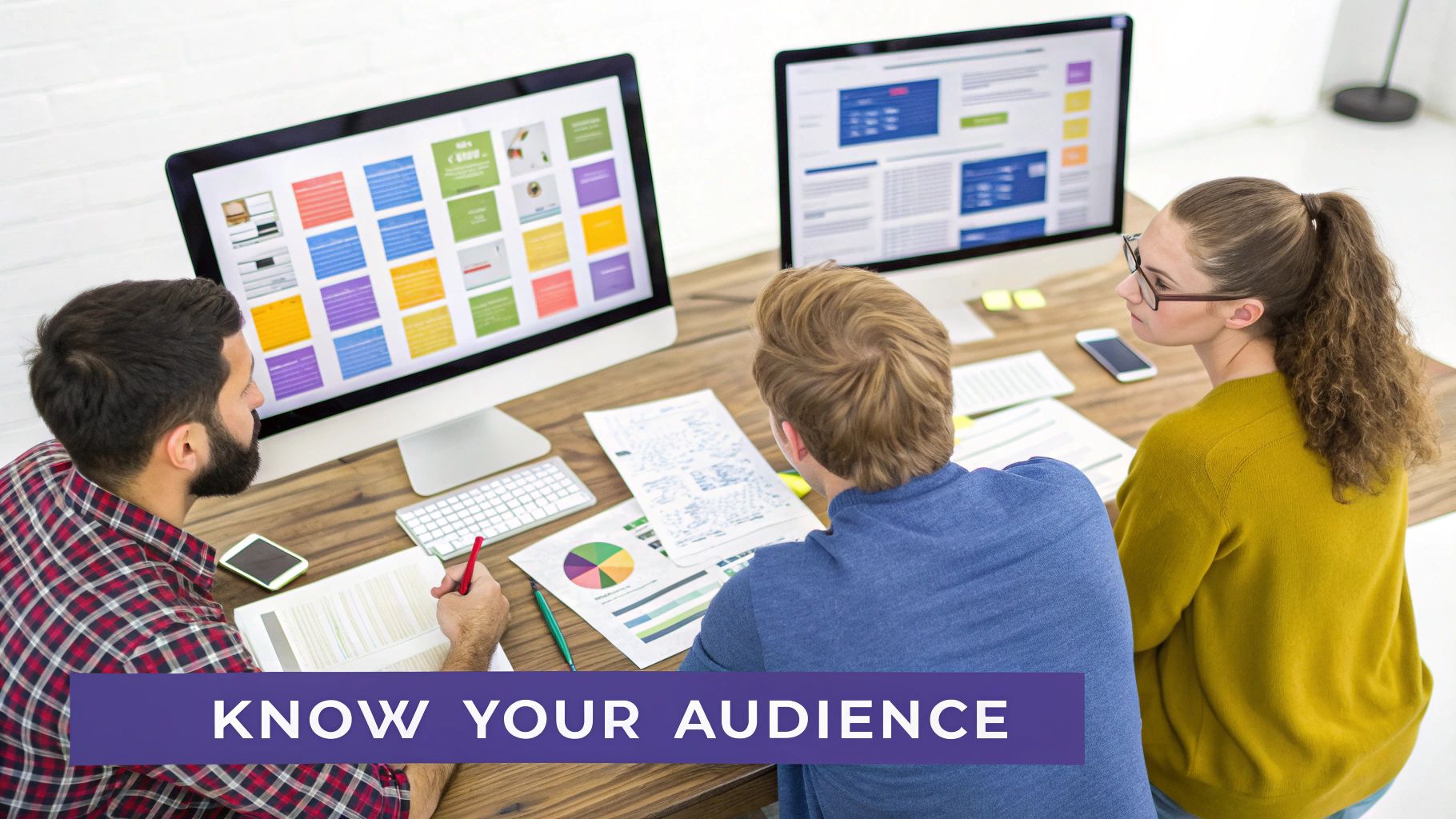
The key takeaway is the power of clarity and planning. Organizing content by theme and type helps you spot gaps and opportunities, which prevents last-minute stress and maintains a consistent brand voice.
Ideation and Workflow Efficiency
To keep your calendar full, you need a dependable way to generate ideas. Don't just wait for inspiration to hit; actively search for it. Excellent sources include customer service FAQs, questions from the sales team, social media comments, and industry forums. Every question is a potential post that directly answers a real audience need.
To help visualize what content performs best, here's a look at how different formats typically measure up across key metrics.
Content Type Performance Metrics
Data-driven insights on how different content formats perform across engagement, reach, and conversion metrics
| Content Type | Average Engagement Rate | Reach Potential | Conversion Rate | Production Cost |
|---|---|---|---|---|
| Short-Form Video | 5.5% - 7.5% | Very High | Moderate | Moderate to High |
| Image/Carousel Posts | 2.5% - 4.5% | High | Low to Moderate | Low to Moderate |
| Live Video | 4.0% - 6.0% | High | Moderate | Low |
| User-Generated Content | 6.5% - 8.5% | Moderate | High | Very Low |
| Blog Post/Article Links | 1.0% - 2.0% | Low to Moderate | High | High |
| Infographics | 2.0% - 3.5% | Moderate | Low | Moderate |
As the table shows, user-generated content and short-form video often lead in engagement, but linking to long-form content like blog posts can be a powerful driver for conversions. A balanced strategy uses a mix of these formats to achieve different goals.
Once ideas are in place, efficiency becomes critical. A smart way to scale content is through repurposing. A single blog post can be transformed into multiple pieces of content:
- A detailed carousel post for Instagram.
- A quick, informative video for TikTok and Reels.
- A professional text update for LinkedIn.
- A shareable infographic for Pinterest.
This approach maximizes the value of your initial work. Automating the scheduling and publishing of this repurposed content is the final step. Exploring social media automation tools like PostSyncer can help manage repetitive tasks, allowing your team to focus on strategy and creativity. This blend of systematic planning, efficient idea generation, and smart automation builds a strong system that delivers consistent value without overwhelming your team.
How PostSyncer Transforms Your Content Management Game
Trying to execute a social media strategy across different platforms can feel like conducting an orchestra where every musician is playing a different song. It’s chaotic and often leads to mixed messages and a burned-out team. This is where a central platform isn't just a nice-to-have; it's a must-have. With the right tool, you stop juggling chaos and start directing a symphony, making sure every post works together to achieve your goals.
PostSyncer is built to be your strategy's command center, bringing every vital piece into one clean workspace. It gets rid of the scattered spreadsheets, disconnected messaging apps, and confusing email chains by creating a single source of truth. By combining planning, creation, scheduling, and analysis, it smooths out the friction that can make even the best strategies fall flat.
Intelligent Scheduling and Unified Publishing
A major challenge for brands is staying active without letting content quality slip. Posting manually to different platforms at their unique peak times is a logistical headache. PostSyncer’s intelligent scheduling feature takes care of this entire process automatically. Think of it as a smart assistant who knows precisely when your Instagram audience is most active and when your LinkedIn network is ready for new ideas.
This automation isn't just a time-saver; it boosts your reach. Brands using this feature see higher initial engagement because their content shows up when people are already scrolling. This means your hard work doesn't get buried in the feed, giving your social media content strategy a better shot at connecting with the right people. You can schedule everything from multi-image carousels to short-form videos for Reels and YouTube Shorts from a single place.
From Raw Data to Actionable Insights
Vanity metrics like likes and follower counts don't tell the whole story. A successful strategy is measured by how it impacts your business goals. PostSyncer’s analytics dashboard cuts through the noise, turning raw performance data into clear, actionable insights that help you grow.
The dashboard below shows how PostSyncer presents performance data, making it easy to see what’s working and what isn’t at a glance.
This visual approach helps you look past surface-level numbers and understand the "why" behind your performance. You can quickly identify which content themes drive the most website clicks or which formats spark the most meaningful conversations.
Streamlined Collaboration and Approval Workflows
When you have multiple people involved, keeping your brand voice and quality consistent is tough. PostSyncer solves this with collaborative workflows that keep everyone on the same page. From a shared media library ensuring everyone uses approved images to a built-in approval process, the platform clears bottlenecks and stops off-brand content before it goes live.
Here’s how it simplifies teamwork:
- Centralized Calendar: Everyone on the team can see the entire content plan on a drag-and-drop calendar, so there's no confusion about what’s scheduled.
- Clear Approval Chains: Assign content to specific people for review. Once approved, the post is automatically queued for scheduling, creating a perfect handoff.
- Real-Time Feedback: Team members can leave comments and suggestions directly on content drafts, keeping all conversations in one spot.
By bringing these key functions together, PostSyncer turns content management from a fragmented chore into a focused, measurable engine for business growth. It gives your team back their strategic thinking time, letting them focus on what really matters: building relationships and creating content that connects.
Distribution Strategies That Turn Content Into Conversations
Creating brilliant content is just the beginning of the story. Think of it like cooking a gourmet meal. If you leave it sitting in the kitchen, no one gets to taste it, appreciate it, or tell their friends how amazing it was. The same is true for your social media content; without a smart distribution plan, even the most creative posts go completely unnoticed. A great social media content strategy depends on distribution to turn a one-way message into a lively community conversation.
This is about more than just hitting the "publish" button. It’s the art of getting your content in front of the right people, on the right platforms, at the exact moment they’re ready to engage. Forget generic advice about posting at 9 AM on a Tuesday. Real distribution pros dive into their analytics to find their audience’s unique digital hangouts and activity patterns, making sure every post lands with maximum impact.

The data above, from a Hootsuite engagement guide, shows how different content types lead to different kinds of engagement. This proves that a winning strategy needs a mix of content designed for specific results, whether that’s getting more shares, comments, or saves.
Amplifying Your Message Without Being Repetitive
One of the biggest mistakes in content distribution is copy-pasting the same exact post across all social media channels. This "one-size-fits-all" method feels lazy and completely ignores the unique culture of each platform. A professional, text-heavy update that performs well on LinkedIn will likely feel awkward and out of place among the fast-paced video trends on TikTok.
Instead, treat your core piece of content as a central idea that you adapt for different audiences and platforms. This creates a connected content ecosystem where each piece supports the others. For instance:
- A detailed blog post can act as the main source of information.
- On Instagram, you can transform key stats from the post into a visually appealing carousel.
- For TikTok or Reels, you could film a short, high-energy video that summarizes the main point.
- On LinkedIn, you might share a text-only post that asks a thought-provoking question related to the article’s theme.
This approach makes your message feel native and fresh on each platform, which drastically increases its chances of being seen and shared. It shows respect for the user's time and context—a critical step in earning their attention.
Community Management: The Heart of Distribution
Distribution isn’t just about pushing content out; it's about pulling people into a conversation. This is where active community management plays a vital role. It's the continuous process of building relationships, encouraging discussions, and turning casual followers into loyal fans. When someone leaves a comment on your post, they are giving you a direct invitation to connect.
Strong community management goes beyond simply "liking" comments. It’s about asking follow-up questions, tagging other users who might find the conversation interesting, and handling negative feedback with grace. A study revealed that 67% of marketers who customized their content for each platform reported a better return on investment, mainly because tailored content sparks more meaningful interactions.
Think of your comments section as a digital town square. As the host, it's your job to make everyone feel welcome, guide the dialogue, and ensure the conversation stays positive and productive. This human touch builds a level of trust and loyalty that no algorithm can replicate. Tools like PostSyncer simplify this by gathering all your notifications in one place, making it easier to respond quickly and manage these crucial interactions across every channel. By focusing on smart distribution and genuine engagement, you build a self-powering cycle of reach and conversation that creates unstoppable momentum.
Measuring What Matters: Analytics That Drive Better Decisions
Posting content without checking its performance is like driving with your eyes closed. You might be moving, but you have no idea if you're headed in the right direction. An effective social media content strategy isn't built on wishful thinking; it's fueled by data that tells you what your audience loves and what actually grows your business. The aim is to look past simple numbers like likes and focus on the metrics that connect your social media work to your bottom line.
Think of your analytics dashboard as the control panel for your strategy. Each metric is a gauge you can check to steer your content correctly. A high engagement rate on a post isn't just a nice-to-have; it's a clear signal that the topic or format resonated with your audience. Likewise, a strong click-through rate means your call-to-action was persuasive. Learning to read these signals is how you turn raw data into smart, profitable decisions.
From Vanity Metrics to Business Impact
To really understand what's working, you need to connect your social media activities to real-world results. While things like reach and engagement are useful for seeing how many people your content touched, they don't paint the full picture. The most powerful metrics are the ones that show a return on investment and prove that your social media efforts are worthwhile. For a deeper look at organizing your data, our social media analytics report template provides a great framework.
Here’s how to shift your attention from surface-level stats to metrics with real weight:
- Awareness Metrics: Keep an eye on reach and impressions to understand how many people are seeing your content.
- Engagement Metrics: Track comments, shares, and saves. These actions are much stronger indicators of genuine interest than simple likes.
- Conversion Metrics: Measure your click-through rate (CTR), lead generation, and sales to see how many people are taking the next step.
- Customer Loyalty Metrics: Look at customer testimonials and user-generated content (UGC) to see how many fans are advocating for your brand.
This layered view helps you see how your content is performing at every part of the customer's journey, from first glance to final purchase.
Conducting Content Audits and A/B Testing
One of the best ways to use your analytics is by performing regular content audits. This just means you systematically review your old posts to find patterns of success. A tool like PostSyncer can make this much easier by highlighting your top-performing content, letting you spot trends without digging through spreadsheets.
The screenshot below from Hootsuite shows a typical analytics dashboard, breaking down key performance indicators across different social networks.
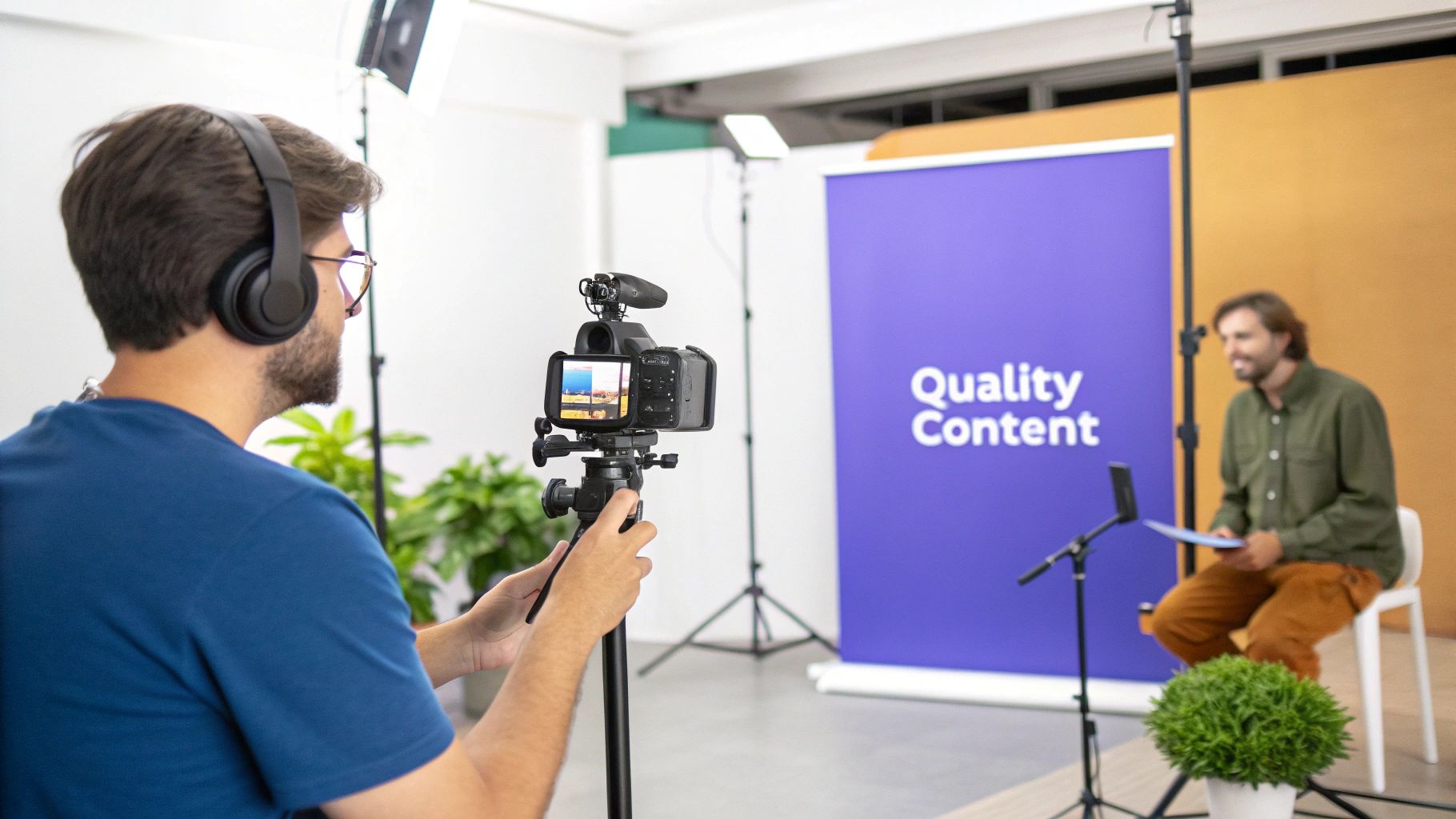
What this data really shows is how important it is to compare performance over time. By checking metrics like follower growth and engagement rates month-over-month, you can quickly tell if your strategy is building steam or if it needs a tune-up.
After your audit shows you what kinds of posts work best, you can fine-tune your approach with A/B testing. This means you create two slightly different versions of a post to see which one your audience prefers. You can test almost anything:
- Headlines: Try a question versus a bold statement.
- Visuals: Pit a static image against a short video or a GIF.
- Calls-to-Action (CTAs): Compare the results from "Learn More" and "Shop Now."
This methodical testing takes the guesswork out of your creative process. It gives you hard data on what truly gets your audience to stop scrolling. By consistently measuring, auditing, and testing, you create a powerful feedback loop that makes your social media content strategy stronger with every post.
Future-Proofing Your Social Media Content Strategy
The only constant in social media is change. Platforms rise and fall, algorithms shift overnight, and audience tastes evolve with new trends. A rigid social media content strategy is a fragile one; a flexible strategy is built to last. Future-proofing your approach isn’t about chasing every shiny new feature, but about building a strategy that can bend without breaking, staying effective no matter what comes next.
Think of your strategy like a modern skyscraper built in an earthquake zone. It’s not designed to be completely rigid. Instead, it has a deep, strong foundation with built-in flexibility, allowing it to sway with the tremors and remain standing tall. Your strategic core—your goals, audience knowledge, and brand voice—is the foundation. Your tactics, platform choices, and content formats are the flexible structures that adapt to the constant shifts of the social media world.
Balancing Innovation with Core Fundamentals
Staying relevant means striking a careful balance. On one side, you need to embrace new technologies and trends. On the other, you can't abandon the proven fundamentals that build real connections with your audience. For instance, artificial intelligence is no longer a futuristic idea but a practical tool for creating and sharing content. AI can help generate initial ideas, analyze performance data, and even suggest the best times to post, freeing up your team to focus on bigger creative work and community interaction.
The key, however, is to use these tools to support, not replace, the human touch. Authenticity is still one of the biggest drivers of brand trust. Use AI for efficiency, but let your team’s personality and empathy shine through in the final product. This blend of machine-powered scale and human-centered authenticity is what will set successful brands apart in the years ahead. It's also vital to know which platforms are gaining traction. For more on this, you can learn about the top social media platforms dominating 2025 in our guide.
This report on 2024 social media trends points out key areas where strategists should be focusing their attention.
The insights from the report highlight the growing role of AI in personalizing content and the unstoppable rise of short-form video, showing you exactly where to invest your creative energy.
Preparing for the Unexpected: Agility and Crisis Management
A future-proof strategy must also plan for the unexpected. A crisis can be anything from a few negative comments on a post to a major issue that damages your brand’s reputation. Having a clear plan in place is not optional. This should include:
- Monitoring social conversations to catch potential problems before they escalate.
- Creating a clear internal communication protocol that defines who responds and what they should say.
- Preparing template responses that can be quickly customized for different situations, ensuring a calm, consistent, and empathetic reply.
This proactive approach to crisis management not only protects your brand but also shows your audience that you are responsive and take accountability. By building a social media content strategy that is agile, aware of new technology, and ready for challenges, you create a solid framework for long-term growth and success.
Ready to build a content strategy that’s both powerful today and prepared for tomorrow? PostSyncer provides the AI-powered tools and analytics you need to organize your workflow and adapt to any change with confidence.
